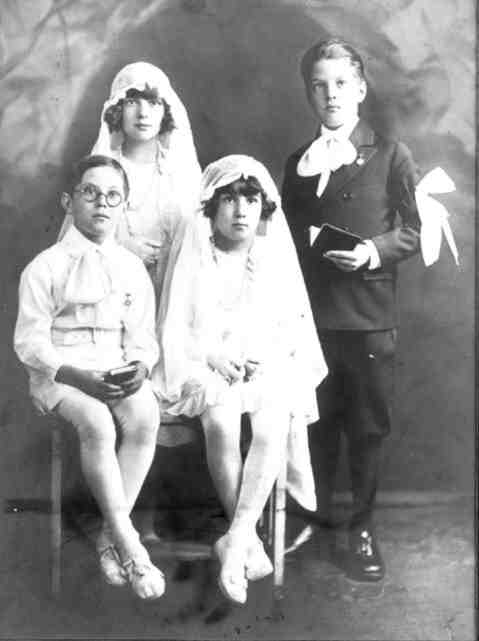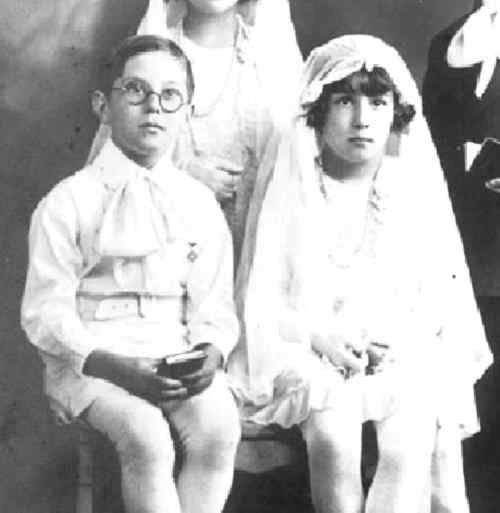
United States First Communion: 20th Century Inter-War Short Pants Suits and Hosiery

Figure 1.--These Brooklyn children are doing their First Communion, the older boy may be doing his confirmation. He probably is wearing dark over-the-knee long stockings with his knickers. The younger boy wears long white stockings with short pants. HBC believes the photograph was probably taken in the early 1920s. Also note the younger boy's shoes.
|
Some boys in the immediate post-World War I era still wore long stockings for First Communion and other formal events. These were genenerally dark long stockings for formal events, but an exception was made for boys wearing white short pants suits. Almost always they wore long white stockings. Socks early in the 1920s generally replaced long stockings. They were much more popular with boys as they did not require restrictive hose supporters. Most boys wore kneesocks for First Communion, even though ankle socks were becoming increasingly popular in America during the 1930s. The kneesocks worn vary. Some are the turn-over-top kneesocks with the cuffs neatly turned down. This was the type of kneesock most commonly worn by American boys. Some photographs, however, show boys wearing kneesocks with out the turn-over-to socks. This was a style more commonly worn by younger boys.
Hosiery Types
Boys in the inter-war era wore three types of hosdiery with First Communion suits: long stockings, kneesocks, and short socks.
Long stockings
Some boys in the inter-war era still wore their First Communion suits with long stockings. This was especially common in the early 1920s and then declined as more and more boys wore kneesocks. Long stockings did not, however, disappear and were in fact worn by some boys as late as the early 1950s. Begining in the 1920s boys began to wear tan long stockings instead of the darker colors that had previously been prevalent. The tan long stockings were generally worn for warmth. White and black long stockings were reserved for formal wear. Almost always for first communion, white long stockings were worn with white suits and balck long stockings with dark suits.
Kneesocks
Kneesocks rapidfly replaced long stockings during the 1920s. Most boys in the 1910s and early 1920s wore long stockings with their First Communion suits. During the mid 1920s this rapidly changed as more and more boys began wearing kneesocks. Most boys preferred the kneesocks as they couldbe worn without the cumbersome hose supporters that are needed with long stockings. The kneesocks worn vary. Some are the turn-over-top kneesocks with the cuffs neatly turned down. This was the type of kneesock most commonly won by American boys. Some photographs, however, show boys wearing kneesocks with out the turn-over-to socks. This was a style more commonly worn by younger boys.
Ankle socks
Few boys wore ankle socks with their First Communion suits during the inter-war era. I do not believe that they were considered sufficently dressy to be worn for such a formal occasion.
Conventions
Some boys in the immediate post-World War I era still wore long stockings for First Communion and other formal events. Long stockings were worn for warmth during the cold winter months. Another important convention for long stockings was for formal occasions which explains why so many boys in the 1920s were pivtured wearing long stockings with short pants First Communion suits.
Colors
Older boys in the early 20t century generally wore dark long stockings with kneepants for formal events. Younger boys might wear white long stockings, but the dark ones were more common. This changed in the interr-war era as boys began wearing short pants suits for first communion.
White suits
Most short pants First Communion suits in the inter-ear era were white. Boys also wore dark suits, but these were more commonly knicker suits. Initially white long stockings were worn with the white short pants suits. After the mid-1920s, however, white kneesockls became increasingly common an exception was made for boys wearing white short pants suits. Almost always they wore long white stockings.
Dark suits
Many boys alsowore dark First Communiion suits. For families of modest means this was a more practical choice. Unlike white suits, they could be worn for formal dress well after a boy's First Communion. Unlike the white suits, however, they were mostly knicker suits. Boys in the early 1920s still wore long dark stockings with these suits. Kneesocks becamer increasingly common in the late 1920s, but because of the formality of the occassion, boys who usually wore kneesocks might wear long stockings with their dark First Communion or Confirmation knicker suits.
Footwear
Boys wearing long stockings with knickers suits wore conventional dark oxford lace-up shoes. Boys wearing short pants communion suits wore more varied footwear. White kneesocks were often worn with white lace-up shoes, especially by the 1930s. White lock stockings might be worn with some kind of strap shoe or sandal, especially in the 1920s. Note the strap sandal the boy in figure 1 is wearing. It also appears to be rather like a soft balet slipper. Hand to tell for sure.
Chronology
Socks early in the 1920s generally replaced long stockings. Long stockings were still quitere common in the early 1920s, but much less so by the end of the decade. Kneesocks were much more popular with boys than long stockings because they did not require restrictive hose supporters. Most boys by the mid-1920s were wearing kneesocks for First Communion, even though ankle socks were becoming increasingly popular in America during the 1930s.

Figure 2.--Notice how long this boys' stockings had to be so that they could be worn with his short pants First Communion outfit. Clothing companies began making long stockings longer in the 1920s because of this.
|
Length
Lonf stockings in the early 20th century were made only long emough tp extend a lottle above the knee as they were worn with kneepants. As boys began wearing short pants, especially shorter cut shoets, long stockings had to be made longer. Some of the short pants younger boys wore in the 1920s and 30s were quite short and thus required very long long stockings. Mail order catologs like Sears mention that the long stickings were made to be wirn with shorter clothing in the long stocking displays.
Age
Boys wwere usually about 7-years old when they took their First Communion, but some boys did it later and were older. Most advertisements for long stockings sow that they were made for boys and girls to about 10 years of age, although some were made in sizes to 12 years.
Country Trends
Long stockings were wore for First Communion in both Europe and America. HBC's information at this time is primarily American.
HBC

Navigate the Historic Boys' Clothing Web Site:
[Return to the Main U.S. interwar First Communion short pants page]
[Return to the Main U.S. First Communion page]
[Introduction]
[Activities]
[Bibliographies]
[Biographies]
[Chronologies]
[Contributions]
[Countries]
[Style Index]
[Boys' Clothing Home]
Navigate the Historic Boys' Clothing Web chronological pages:
[The 1900s]
[The 1910s]
[The 1920s]
[The 1930s]
[The 1940s]
[The 1950s]
Navigate the Historic Boys' Clothing Web style pages:
[Short pants suits]
[Blazers]
[Jackets]
[Kilts]
[Sailor suits]
[Sailor hats]
[Ring bearer/page costumes]
[Shortalls]
[Long stockings]
Created: June 3, 2000
Last edited: April 24, 2003




